Content warning: this story contains graphic descriptions of police violence and brutality
On Friday, July 17, a protest centering Black and Indigenous lives and calling to #DecolonizeZhigagoong became a violent, high-profile encounter between police and protestors.
We’ll pause that description, for now.
Over the past two months, there have been a lot of conversations in the 14 East newsroom and between our fellow journalists about how to cover protests. We are an independent publication that focuses on community and engagement. We are run by a group of young people who are themselves deeply invested in making stories more accessible, making journalism more inclusive and finding better, more equitable ways to speak truth to power.
Being an independent, student-run newsroom in this moment in history has been difficult. In the onset of COVID-19, we could not send reporters into the field at the risk of their own health. All of our reporting went remote. When the #BlackLivesMatter uprisings began in June, our conversations around the need to protect our health and safety while reporting took on another layer.
Not only could we not ask reporters to risk COVID-19 infection for unpaid work, we could also not let them risk severe injury or arrest at the hands of the police. Although reporters are not a protected class, we saw early on that police weren’t thinking twice about saving face in front of cameras and press badges. We saw journalists from La DePaulia shoved, an anchor from CNN arrested and a reporter in Minneapolis lose her eye to a rubber bullet. We can’t regularly pay our staff, let alone support their medical or legal costs.
So the rule was set: anyone on official assignment from 14 East needed to conduct interviews remotely. For the comparatively smaller, DePaul-specific protests we’ve covered, reporters still needed to disclose all of their plans to the other editors, and maintain a six foot distance from the crowd whenever possible, in addition to following all of our regular protest coverage policy.
Otherwise, reporters could choose to attend protests independently, as freelancers. That’s what Assistant Engagement Editor Grace Del Vecchio has been doing all summer long, which has included live-tweeting protests and writing stories for various Chicago publications.
Many others have been attending these demonstrations with no credentials, no assignment, just as protestors. For many of us on staff, this summer of protesting has been an exercise in drawing boundaries and understanding that sometimes, you put down the pen and badge and pick up a sign.
But after Friday, July 17, we feel a little differently.
How it’s been covered
Mainstream coverage is mixed. It’s become abundantly clear that some outlets in the city see these protests as important events from beginning to end. Others seem to associate newsworthiness with flashing lights and sirens, swooping in after it’s all said and done for footage of the aftermath. Some outlets have been focusing on the progress, message and goals of the Black Lives Matter movement, while others have chosen to home in on what objects were thrown at police before the beatings and pepper spray began.
We know that we are experiencing history and, student publication or not, we have to cover it correctly. As we document history, we have been asking ourselves many questions, both as reporters and protesters.
Where is our focus, and what decides that focus? Do we want to be among the swath of mainstream media who continue to trivialize the efforts and actions of activists? Or, do we want to highlight the voices of those who have been fighting for their rights, their livelihoods and for a future filled with justice?
Because, let us be clear, there is a difference between this and the majority of coverage that we’ve seen from mainstream media.
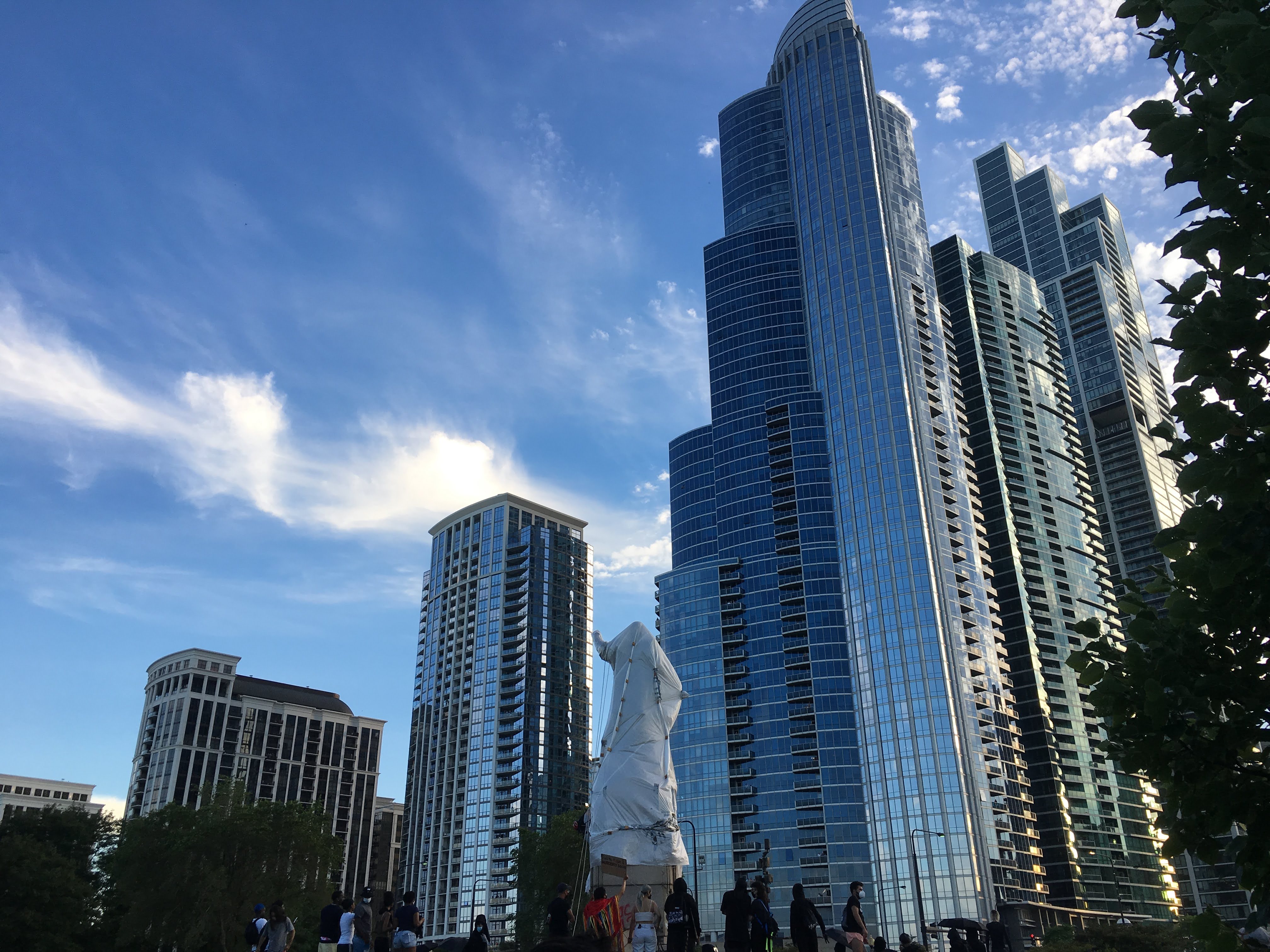
Photo submitted by E, a DePaul student.
Over a week after the July 17 protest, the Columbus statues in Grant Park and Little Italy have been removed “until further notice” by Mayor Lori Lightfoot. Protests are still surging throughout the city and residents and activists are growing anxious amidst threats of federal agents taking to the streets like we’ve seen in Portland.
We must ask the crucial question: what kind of government chooses to harm its people for the sake of protecting stone?
The impact of a water bottle hitting a police officer in riot gear is not comparable to that of a protester being hosed down with pepper spray and beaten with a baton.
The experience of crawling on the ground, choking on pepper spray as a person in blue stands above you brandishing a baton isn’t just a difference in opinion or perspective. One position is traumatic, the other an abuse of power.
Hundreds of people flooded to Grant Park that evening to stand in solidarity with the Black and Indigenous people of Chicago. We didn’t speak with every individual present that night, but we can say with confidence that protesters were not looking for violence. They were looking for respect. Something they were not granted.
“We are not here for temporary changes… people are scared of water bottles and umbrellas and I’m scared of being a shot at a protest,” said @GKMC18 organizer. #ColumbusStatue #ChicagoProtests pic.twitter.com/J7ZdiuWNDf
— Grace Del Vecchio (@delvecchiograce) July 25, 2020
What happened that day from those who were there
Here, four DePaul students who were present at the July 17 protest share what they witnessed at the #DecolonizeZhigaagoong protest in Grant Park: 14 East Editor-in-Chief Francesca Mathewes shares her first-person perspective alongside activist and incoming freshman Miracle Boyd and two anonymous respondents to 14 East’s call for first-person accounts who will be referred to as E and L. The story below is a combination of these perspectives.
I’ve been attending protests pretty consistently all summer, and after seeing the level of escalation that has happened across the country, I have been mindful of taking safety precautions: always attending with a friend or two, not wearing my contacts, having an extra mask on me and even bringing safety goggles and a bike helmet, just in case. For the most part, these measures ended up being for the sake of “better safe than sorry.”
This was the first protest I had been to since June that I left those things at home. Although in retrospect this was an incredibly naive choice, I hadn’t seen or heard of protests becoming violent since at least June. My mindset as I arrived at Buckingham Fountain at around 6 p.m. was relaxed as I joined my friends in the crowd. The final speaker closed out the initial rally with a speech about solidarity and safety — remarking on how we, the protestors, can and should keep one another safe when it came time for the demonstration to disperse. There were some one-sheeters going around explaining what to do if you get arrested, but none of this indicated to me that a serious altercation lay ahead.
The mood remained light, almost celebratory, as we marched south on Columbus Drive. There were drums, chants of “No justice, no peace!” I was toward the back of the several hundred protestors being led by banners painted #DecolonizeZhigaagoong, #BlackandIndigenousLivesMatter and #AbolishCPD. We came to the southeastern edge of Grant Park where there was some sort of hold up — I now know that this was the first wave of protesters trying to drive police away from the Columbus Statue, which created a standstill for those of us still in the street.
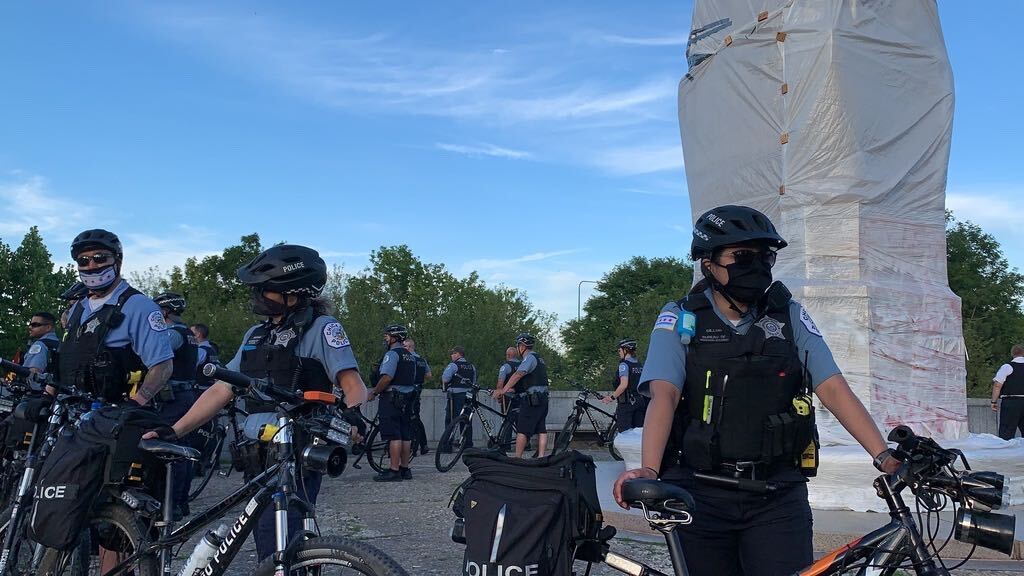
Photo by Grace Del Vecchio, 14 East
As we moved into the park, it became clear to myself and those around me what the plan was. This was an attempt to remove the statue. At this point, the police presence was still low (I now know they had retreated for backup) and protestors were running towards the statue, cheering, playing music, setting off fireworks and starting to arrange themselves around the statue.
That’s when a shift happened.
A DePaul student who shared their story via 14 East’s Google Form, who will be known in this story as “E,” described a similar experience.
E, who said she was also not aware of the plan to remove the statue, started to feel a shift when she noticed the increasing number of helicopters ahead.
“It was initially just one police helicopter, but quickly grew to multiple, including news helicopters,” she said in a follow-up interview with 14 East. “There was a constant siren presence, but I couldn’t see the cops quite yet.”
It was at this point that I could see a wave of bright blue helmets through the hedges on Columbus Drive. I was linked arm in arm with my friends in front of the statue, where someone was beginning to ascend the statue with the help of other organizers. At this point, I took out my contacts, trying to watch the line of police through the barricade of bicycles that protestors had created at the main entrance.
I first saw police break the line of protestors on Roosevelt Road, where they began running downhill. That’s where I saw the beatings begin.
“They ran from the side, down the hill, indiscriminately pepper spraying and beating protestors in an attempt to break through the line,” said a recent DePaul graduate who responded to 14 East’s Google Form, who will be known as L.
More protesters have been pepper sprayed but the protesters hold the hill where the #ColumbusStatue sits #ChicagoProtests pic.twitter.com/gAX2Wd1pa3
— Grace Del Vecchio (@delvecchiograce) July 18, 2020
It was at this point that I saw one woman, one of the first people to be hit by police, crawling toward me, covered in blood. Another young man was running toward medics on the north side of the park, his nose clearly broken.
Organizers were instructing people to stick together and to protect people of color from police. Protesters from all angles screamed, “We need white bodies, we need white bodies.” White protesters joined bike marshals, positioning themselves in between the line of police and Black and Brown protesters.
The message resounded: keep each other safe. Funny, how protesters clambered to keep each other safe from those who swore to protect them.
I have since, in describing this incident to family, talked about the feeling beyond fear. I have never felt the collective emotion of so many people who were not just afraid, not just panicked, but were genuinely trying to save themselves and others from serious harm.
There was a moment of pause as we all realized the statue wasn’t coming down. It was just too sturdy for the set of rope, and the police quickly capitalized on this moment of confusion to force out the rest of the protest with whatever means necessary.
The message resounded: keep each other safe. Funny, how protesters clambered to keep each other safe from those who swore to protect them.
“My sister, who was near me, got thrown about five feet,” E said. “An officer, brandishing a wooden baton, yelled, ‘Back up your bike or you’re gonna lose it!’ at me. I could tell they weren’t bluffing. I looked around and saw cops seizing people’s bikes and throwing them down the hill, careless of if they were going to hit anyone.”
As the police forced people out of the park, I retreated back up the hill with my friends and other protestors as organizers instructed us to return to Buckingham Fountain. People were screaming for water and for medical attention. I saw someone literally vomit in the grass due to how hard they were coughing — the mace cloud that the police had released was, at this point, all consuming.
“My friend and I were gagging so badly we almost threw up multiple times, and only my inhaler managed to save both us from full-blown asthma attacks right then and there,” said L.
Something that occurred to me as I watched people rip off their masks — which were now completely tainted with pepper spray and therefore burning peoples’ faces — is that we are still in a global pandemic. To use a gaseous chemical that attacks the lungs, forcing people to forcefully cough, felt sinister.
Pepper sprayed was just sprayed everywhere, protesters retreating #ChicagoProtests #ColumbusStatue pic.twitter.com/C9vgwh6MNN
— Grace Del Vecchio (@delvecchiograce) July 18, 2020
Back on Columbus Drive, the remaining protestors tried to wash off pepper spray while organizers gathered everyone in a circle protected by bike barricades on either side, ensuring that people could find their friends or partner up for a safe exit. People seemed shaken up, but morale was still definitely high.
“It was honestly terrifying to see these police officers up close. You could see that, as they pushed us down the hill, they were enjoying it,” said E. “It was easy to read their faces — none of them were wearing masks — some had plastic face shields. It feels like, in order to do their jobs properly, they’ve learned to ignore the fact that they’re interacting with other humans. It must be easier that way.”
— Grace Del Vecchio (@delvecchiograce) July 18, 2020
Among the DePaul students present was Miracle Boyd, an incoming freshman and activist with GoodKids MadCity, whose story has since gone somewhat viral. Boyd was punched in the mouth by a CPD officer while recording the arrest of another protestor — an incident which, itself, was caught on video.
Boyd rushed over to help another protester who was being arrested and asked for their name and date of birth so that she could get him legal assistance.
It was then when two police officers approached Boyd, one she described as having dark gray facial hair and glasses.
“He walked up to me and smacked me,” Boyd said in an interview with 14 East reporter Grace Del Vecchio. “I don’t know if the phone hit me in the mouth, I don’t know if his hand hit me in the mouth. But the way that I was recording, I think that he tried to smack the phone in my hand and he hit me at the same time, and the phone hit me in the mouth, and it knocked my tooth out and I was bleeding.”
Boyd backed away, clutching her month in pain and dropping her phone. She said she wanted to get the badge number of the cop that hit her so that she could report it later, but her friends encouraged her to leave.
“I was just crying hysterically. I looked on the ground for my phone, and it was gone and I just ran away,” she said.
After Boyd’s personal account of the altercation was published by the TRiiBE and Block Club Chicago, she has since shared her experience at a press conference held by GoodKids MadCity and at several other actions around the city.
In a press conference on Monday, July 20, CPD Police Superintendent David Brown said that in the future, officers assigned to protestors will wear full protective gear, saying that “agitators” hijacked the protest.
“What began as a peaceful protest at Grant Park Friday evening devolved into a very dangerous situation in which mob action deliberately sought to injure officers, provoke retaliation and damage property. Forty-nine Chicago police officers were injured. Forty-nine,” Brown said. “Eighteen of whom were sent to area hospitals for their injuries.”
Brown did not address the incident with Boyd directly.
Boyd has made it clear that while she wants the CPD officer to be relieved of his duties, she also wants to take part in restorative justice peace circles with him.
This is something that many legacy publications and viral sound bites have repeatedly left out of its coverage of Boyd’s story.
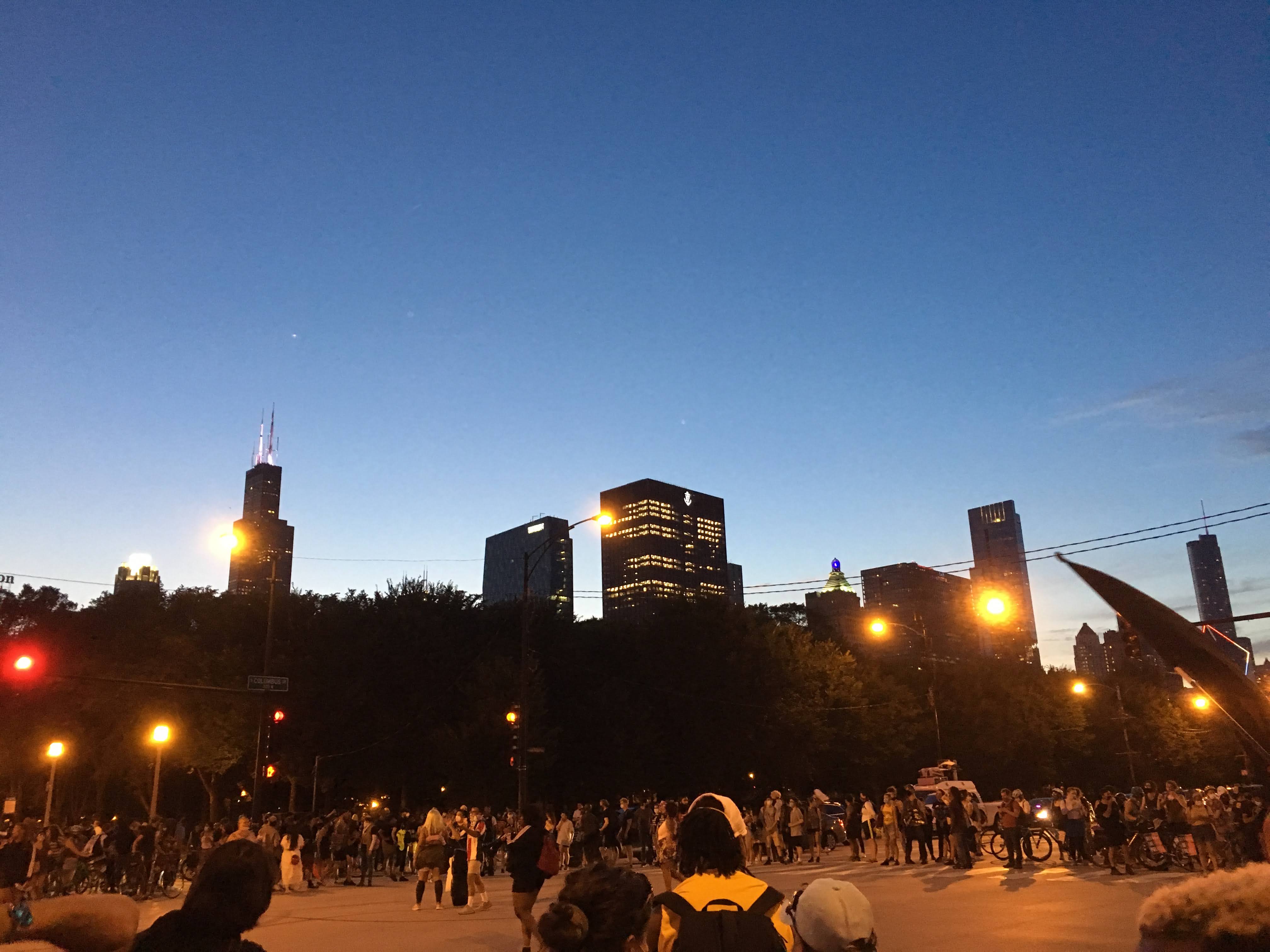
Photo submitted by E, a DePaul student.
The response at DePaul
On the evening of July 18, the DePaul Black Student Union (BSU) released a statement of support for Boyd while denouncing the university’s continued relationship with the Fraternal Order of Police.
BSU President Keith Norward commented on the connection between the fight for DePaul to end its partnership with the FOP and the larger citywide call to defund the CPD.
“I think it’s more clear than ever, how that the situation with Miracle is a direct result of DePaul not cutting their ties with CPD,” said Norward. “I can’t imagine Miracle wanting to come to DePaul knowing that we still have that relationship. Knowing what just happened to her, and knowing that it can possibly happen again, right on her campus, which is supposed to be safe, which is supposed to be a second home.”
“What else needs to happen for [DePaul] to do something? What more needs to happen? This is still a problem.”
Boyd said that she is thankful for the support of the union and looks forward to attending DePaul in the fall however, she made it clear that cops don’t belong anywhere at the university.
“There should be no police, in any form of educational presence there is,” said Boyd. “There should be no police in any educational practice, place, anything like that, because like I said once before, there is no real proof. There is no data, there is no numerical data that proves police keep communities safer.”
BSU is one many DePaul student organizations calling to break ties with the FOP and for some, the incidents from the Grant Park protest have only heightened these calls.
“What else needs to happen for [DePaul] to do something?” said E. “What more needs to happen? This is still a problem.”
In an email response to 14 East’s request for comment on July 23, DePaul spokesperson Carol Hughes reaffirmed the university’s “unequivocal support for Black Lives Matter and the belief that current programs provide the opportunity for education and change.”
She also said in the email that there have been no changes to the University’s relationship with the FOP or CPD since Interim Provost announced on June 22:
“Our university is dedicated to providing students an education imbued with Vincentian values of social justice and transforming society to serve the most vulnerable. We are called to provide access to high-quality education to all.
“Black Lives Matter. We know George Floyd, Breonna Taylor, Laquan McDonald and so many others should still be alive. We also know education can be part of making the change we all want to see in police departments. We support all who are working to make police reform a reality.”
Moving forward
On August 1, Solidarity Street — an organization composed of colleges throughout the city of Chicago — will be hosting a rally in Millennium Park to demand the colleges and universities cut ties to FOP and CPD, among other demands.
In the days following #DecolonizeZhigaagoong and the removal of the Columbus statue, there have been a variety of responses from city residents. There was a #BacktheBlue protest, which saw crowds support the Chicago Police Department. There have been block parties and marches in support of Black Lives Matter. And citywide, all eyes are on Chicago’s mayor as she tries to assure people that the “federal troops” coming to Chicago will not add to the violence. Momentum is still high, and the debate around police and prison abolition in this country is very much alive.
Nonetheless it’s clear that for some, it remains easy to just tune out.
“After we abandoned the statue and lined up across the sidewalk, once we could take a breath, I realized that there were people just … walking through the park. They were just doing normal things,” said E.
“‘I just kept thinking … ‘What are you doing here? Are you that unaware?’ It’s not just ignorance. It’s pretending. It was such a display of privilege, to walk the line between police and protestors. Choose to be in this moment, or not.”
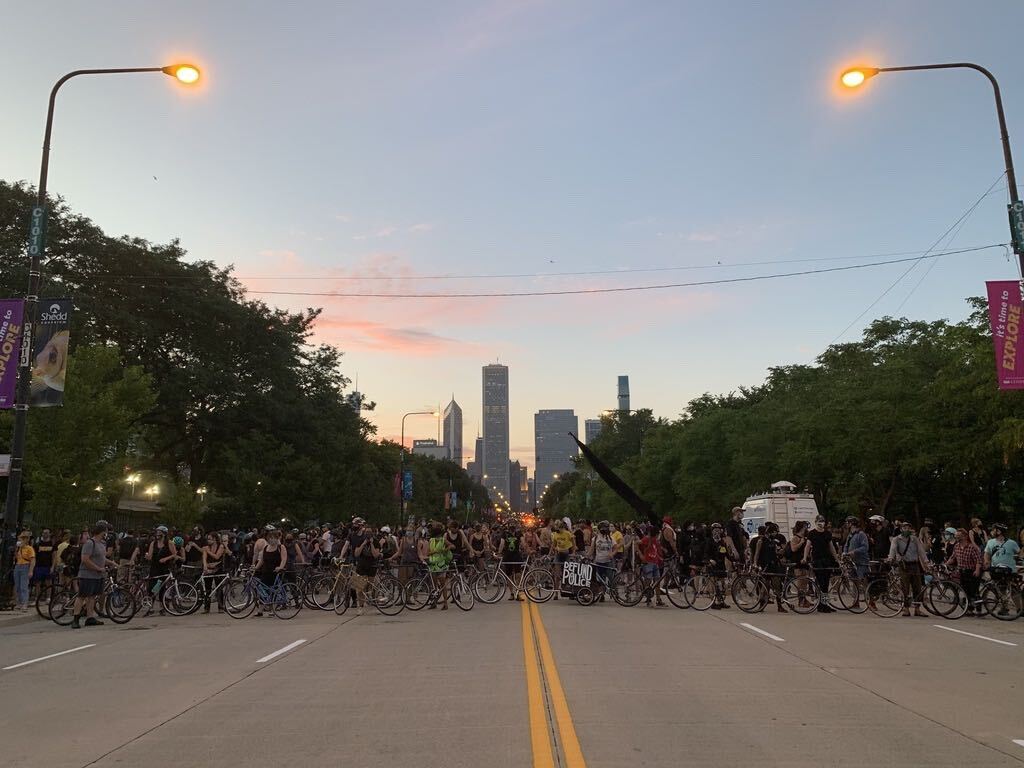
Photo by Grace Del Vecchio, 14 East
The violence we witness and experience at protests and demonstrations can have an impact on our mental health. If you or someone you know is experiencing signs of trauma, including fatigue, increased anxiety and fear, insomnia or withdrawing from your friends and family, consider opening up to a therapist or seeking out some of these free mental health resources, including Chicago’s own Sista Afya, a mental wellness organization that provides low-cost therapy and free support groups for Black women.
If you or someone you know experienced or witnessed an incident involving police misconduct or brutality, reports can be filed on the Civilian Office of Police Accountability’s website. Reports can also be filed via phone to 312-743-COPA (2672), and the status of an investigation can be checked at 312-746-3609.
Header photo by Grace Del Vecchio


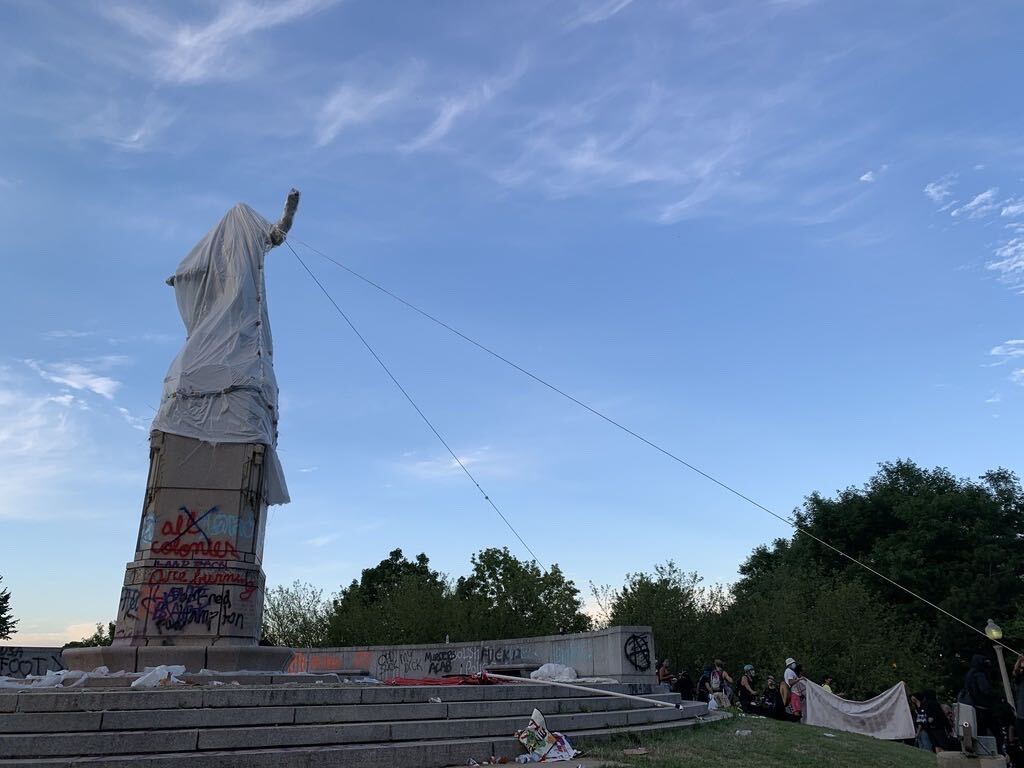

NO COMMENT